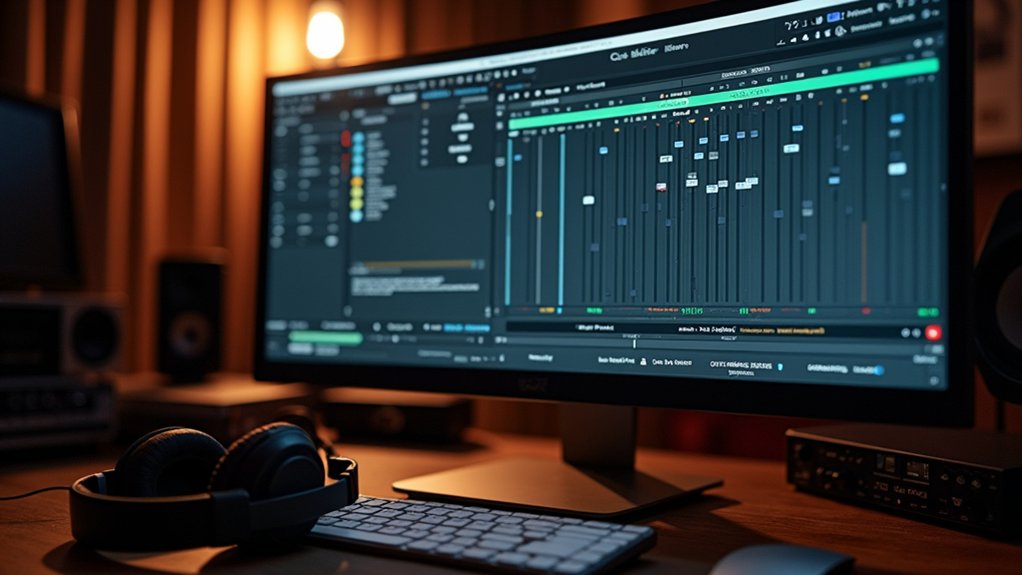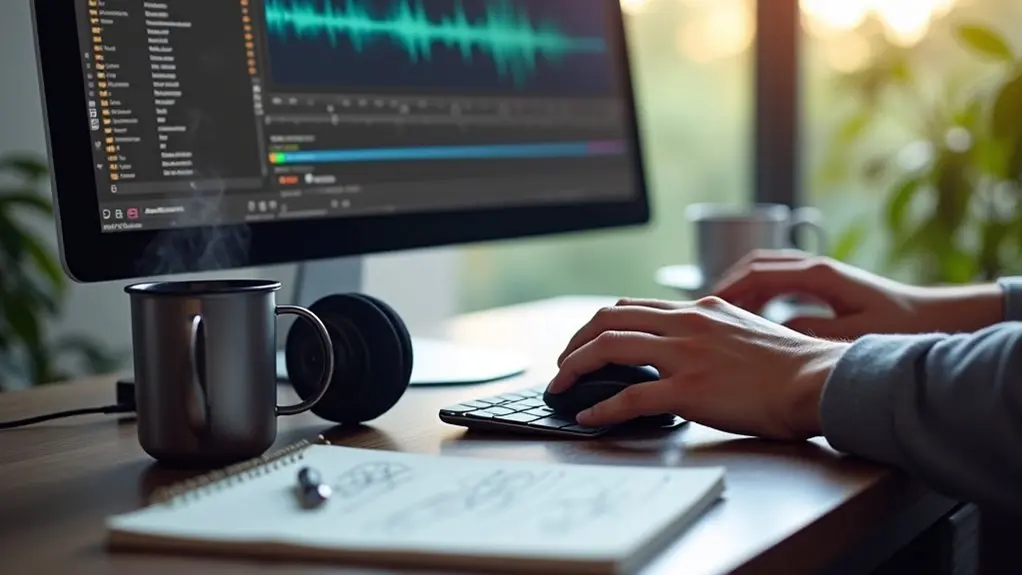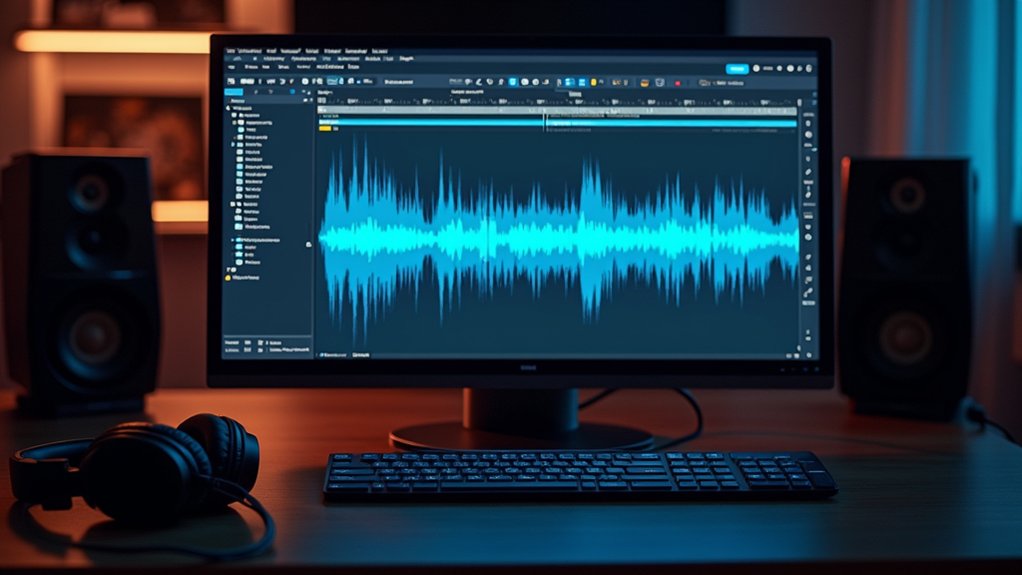Audacity can be installed on a Chromebook through the Linux (Crostini) environment using the command `sudo apt-get install audacity` or via Flatpak for newer releases. Precise microphone selection, input gain calibration, and storage management in the Linux Files directory are critical for peak workflow. Users should monitor recording meters and apply noise mitigation techniques. Regularly exporting projects as WAV or MP3 guarantees data integrity. Advanced troubleshooting, update strategies, and alternative editors are discussed in the following sections.
Key Takeaways
- Install Audacity on your Chromebook via the Linux (Crostini) environment using the Terminal command `sudo apt-get install audacity`.
- Store all audio files in the Linux Files directory for seamless access and compatibility with Audacity.
- Grant microphone permissions in Chrome OS settings and select your preferred input device within Audacity to ensure proper recording.
- Use Flatpak to install a newer Audacity version if you need the latest features beyond what APT provides.
- Consider web-based alternatives like Soundtrap or BandLab if you encounter compatibility or performance issues with Audacity on your Chromebook.
Installing Audacity via Linux on Chrome OS
To deploy Audacity on a Chromebook, one must utilize the Linux (Crostini) environment by accessing the Terminal and executing the command `sudo apt-get install audacity`, which invokes superuser privileges to retrieve and install the package from the official Debian repositories.
This method leverages the apt package management system, ensuring that all dependencies required to install Audacity are automatically resolved and fetched.
After the apt-get install sequence completes, the Audacity binary and associated libraries are integrated into the Linux container. Users can then locate the Audacity launcher within the Chrome OS app drawer under “Linux apps.”
It is essential to verify that audio files are stored within the Linux Files directory to guarantee compatibility and streamlined access for editing and exporting operations in Audacity on Chromebook hardware.
Configuring Microphone and Audio Settings
Frequently, successful audio capture in Audacity on a Chromebook necessitates proper configuration of both the Chrome OS system settings and the application’s input parameters. First, Chrome OS users must explicitly grant microphone access within the Linux container for Audacity to detect hardware input. Once enabled, Audacity’s device toolbar should be used to select the preferred microphone device. Monitoring the recording meter continuously is critical for avoiding clipping and maintaining ideal audio quality. For best results, physical setup is also paramount: employing a pop filter and positioning the microphone consistently reduces plosive distortion and improves clarity. To address echo or hollowness, users should experiment with placement and acoustic isolation. Audacity supports multi-track audio editing capabilities for professional podcast production, enabling users to layer and manage audio tracks effectively. The following table summarizes key configuration steps:
| Setting | Action | Impact on Audio Quality |
|---|---|---|
| Linux Mic Access | Enable in Chrome OS settings | Guarantees microphone is usable |
| Input Device | Select in Audacity | Correct audio routing |
| Recording Meter | Monitor levels | Prevents distortion/clipping |
| Physical Setup | Use pop filter/placement | Reduces noise, improves clarity |
Comparing Flatpak and APT Installations
When comparing Flatpak and APT installations of Audacity on a Chromebook, users encounter significant differences in version availability, with Flatpak often providing access to more recent builds due to its independent packaging and sandboxed architecture.
Update frequency and maintenance are streamlined in Flatpak, as applications are decoupled from system repositories and managed on a per-user basis, while APT relies on system-wide updates through official channels.
Storage and integration further contrast; Flatpak installations reside within user-specific directories to facilitate version isolation, whereas APT integrates applications directly into the system hierarchy.
Version Availability Differences
Although both Flatpak and APT offer mechanisms for installing Audacity on a Chromebook’s Linux container, significant disparities exist in version availability and update cadence.
The APT install pathway sources Audacity version 3.2.4 from Debian or Ubuntu repositories, which are often lagging behind upstream development.
Conversely, the Flatpak install frequently provides access to more recent Audacity versions, such as 3.6.4, reflecting upstream releases with shorter latency.
This divergence means feature sets, bug fixes, and supported plugins may differ substantially between installation methods.
Flatpak’s containerized architecture also enables isolated versioning, allowing multiple versions to coexist, which is not feasible with APT.
Consequently, users prioritizing the latest version or advanced plugin compatibility tend to favor the Flatpak install channel over the traditional APT repository.
Update and Maintenance Ease
Version disparities between APT and Flatpak installations directly influence update and maintenance workflows for Audacity on Chromebooks. The apt install method leverages the operating system’s own package repositories, typically prioritizing stability over rapid access to the latest version.
Flatpak, however, decouples application updates from the base system, presenting distinct maintenance characteristics:
- Flatpak provides expedited access to the latest version of Audacity, such as 3.6.4, through independent update channels, enabling feature parity with upstream releases.
- Updates managed via apt install are subject to repository refresh cycles, often lagging behind Flatpak in delivering new features or patches.
- Flatpak’s sandboxed architecture facilitates atomic updates without dependency conflicts, whereas APT installations are tightly coupled to system-level package dependencies, complicating selective upgrades.
This delineation shapes maintenance strategies considerably.
Storage and Integration
Given the divergent architectures of Flatpak and APT, storage utilization and system integration for Audacity installations on Chromebooks differ markedly.
Flatpak packages encapsulate dependencies within the application bundle, resulting in higher disk consumption and potential redundancy—a critical concern for storage management, especially on devices with limited capacity.
Conversely, APT-installed Audacity leverages pre-existing shared libraries, optimizing storage efficiency by minimizing duplication.
From an integration standpoint, APT installations afford direct access to system resources and seamless interoperability with local files, streamlining workflows.
In contrast, Flatpak’s sandboxed environment enhances security but introduces complexity, requiring explicit configuration for file system and microphone access.
Users prioritizing minimal resource overhead and deep system integration may favor APT, whereas those seeking up-to-date features might opt for a Flatpak-installed Audacity.
Managing Audio Files and Project Storage
Centralizing audio assets within the Linux Files directory is essential for efficient project management when using Audacity on a Chromebook. After installing Audacity, managing audio files requires precise handling and structured organization to optimize workflow and file accessibility.
To streamline this process:
- Transfer all raw and edited audio files into the Linux Files directory using the Files app, ensuring direct access for Audacity’s import/export functions.
- Implement rigorous naming conventions and hierarchical folder structures within Linux Files, preventing misplacement and facilitating quick retrieval of projects and assets.
- Regularly export completed projects in interoperable formats such as WAV or MP3, and sync them with cloud storage platforms like Dropbox or Google Drive for redundancy and cross-device accessibility.
For enhanced audio quality, apply a high-pass filter to remove low-frequency noise, which clarifies recordings and enhances overall sound quality.
Effective management guarantees seamless editing, robust backup practices, and simplified collaboration across diverse platforms.
Improving Recording Quality on a Chromebook
Enhancing audio fidelity on a Chromebook requires strategic optimization of the recording environment and judicious microphone selection. Employing external USB microphones, combined with sound-dampening measures such as soft furnishings and physical barriers, greatly mitigates ambient noise and acoustic reflections. Careful calibration of input devices further guarantees that signal integrity is maintained throughout the recording process in Audacity. To achieve superior sound fidelity, it is recommended to choose a high-quality condenser microphone, which captures nuanced audio details effectively.
Optimizing Recording Environments
While recording with Audacity on a Chromebook, achieving ideal audio fidelity necessitates deliberate control over the acoustic environment. Enhancing the surroundings is critical for effective noise reduction and maximized input quality, particularly when utilizing USB microphones.
Environmental modification addresses both ambient and transient noise artifacts, which are commonly exacerbated by reflective surfaces and background activity. The following strategies are recommended:
- Strategic Placement: Position the USB microphone within 6–12 inches of the desired sound source to enhance direct signal capture and attenuate extraneous noise.
- Acoustic Dampening: Employ soft materials such as curtains, carpets, or even small, enclosed spaces (e.g., closets) to disrupt reverb and echo pathways.
- Sound Check and Input Calibration: Perform preliminary test recordings to monitor input gain, avoiding clipping or distortion, and ensuring ideal signal-to-noise ratios.
Microphone Selection Tips
Selecting an appropriate microphone is paramount for achieving high-fidelity audio capture on a Chromebook, especially when utilizing Audacity for recording tasks.
For ideal audio recording, microphone selection tips include prioritizing external USB microphones, as integrated microphones often exhibit limited frequency response and inferior signal-to-noise ratios. It is essential to verify that Linux subsystem microphone support is enabled, ensuring Audacity’s seamless device recognition and utilization.
Employing a pop filter is recommended to attenuate plosive transients, thereby enhancing waveform clarity and intelligibility. Consistency in mouth-to-microphone distance is critical for maintaining uniform amplitude levels across recording sessions.
Experimentation with spatial orientation and environmental acoustics is advised to mitigate resonant echoes and extraneous noise, enhancing the signal integrity and overall production quality for Chromebook-based audio recording workflows.
Troubleshooting Common Audacity Issues
When operating Audacity on a Chromebook, users may encounter a range of technical issues stemming from hardware integration, application configuration, or Chrome OS-Linux subsystem limitations.
The unique environment of running audio editing software like Audacity on a Chromebook can introduce specific troubleshooting requirements.
Key issues and solutions include:
- If the “Error opening sound device” message appears, verify that microphone permissions are granted in Chrome OS’s Linux settings, and confirm Audacity’s audio input configuration is correct.
- To address recording dropouts, duplications, or latency-based echo and delay, meticulously adjust both the Audacity latency preferences and the Chromebook’s input device parameters for ideal signal flow.
- For playback anomalies—such as low-level hiss in exported files—scrutinize track mixing and balancing before export, and resolve launch-time crashes by disabling problematic plugins or resetting Audacity’s configuration.
To achieve a cleaner sound and enhance the overall audio quality, ensure the entire track is selected before applying noise reduction techniques in Audacity.
Exploring Alternative Audio Editing Solutions
Resolving technical challenges in Audacity on a Chromebook underscores the inherent constraints of running traditional desktop audio editors within a Chrome OS-Linux container. To circumvent these limitations, users seeking to produce their first podcast or engage in advanced audio editing should consider cloud-native alternatives. Solutions like Soundtrap offer DAW-grade, browser-based audio manipulation with collaborative features, while Anchor streamlines the podcast workflow from recording to distribution. BandLab introduces multi-track editing and social integration, optimizing it for Chromebook environments. For lightweight requirements, WavePad provides essential editing tools via a web interface, eliminating installation overhead. GarageBand, accessible on iPad or Mac, remains an option for users within the Apple ecosystem.
| Solution | Key Features |
|---|---|
| Soundtrap | Real-time collab, browser-based DAW |
| Anchor | End-to-end podcast suite |
| BandLab | Multi-track, cloud, social sharing |
Frequently Asked Questions
Can You Run Audacity on a Chromebook?
Running Audacity on a Chromebook involves circumventing Chromebook limitations by activating the Linux container and installing via terminal commands. Users may encounter compatibility issues and limited feature sets, prompting consideration of Audacity alternatives optimized for Chrome OS environments.
What Is the Equivalent of Audacity for Chromebook?
The equivalent to Audacity for Chromebook involves utilizing cloud-based audio editing Chromebook apps such as Soundtrap, Anchor, and TwistedWave. These platforms facilitate multi-track editing, real-time collaboration, and direct browser-based workflow, albeit with feature-set variations compared to Audacity.
What Not to Do With a Chromebook?
Common mistakes include disregarding Chromebook limitations, such as attempting to install incompatible executables, neglecting Chrome OS updates, overloading system resources with intensive applications, installing unverified extensions, and failing to maintain regular cloud-based data backups, potentially compromising performance, security, and data integrity.
Can You Do an Audio Recording on a Chromebook?
Audio recording on a Chromebook is feasible by configuring Chromebook microphone settings within Chrome OS, utilizing Linux container applications. Audio recording tips include enabling microphone permissions, using an external USB microphone, and establishing an acoustically controlled environment for ideal fidelity.
Conclusion
Utilizing Audacity on a Chromebook, while non-native, is feasible through the Linux (Crostini) environment, with users able to select between Flatpak and APT package management for installation. Success hinges on meticulous configuration of ALSA and PulseAudio settings, effective management of file system permissions, and optimization of input devices. Persistent troubleshooting may be required due to hardware and compatibility limitations. For streamlined workflows, alternative cloud-based or Android-compatible digital audio workstations may offer enhanced Chromebook integration.




